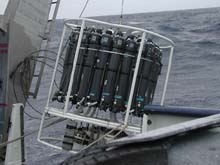
Deployment of the conductivity, temperature, and depth (CTD) meter at the Brine Pool site. Notice the stormy seas in the background. Click image for larger view.
Deploying the CTD
Student Report
February 15, 2003
Michael S. Berger, Doctoral Candidate
Oregon Institute of Marine Biology
University of Oregon
Many operations performed at sea are weather dependent. Submersible dives are no exception. If the wave height is over 5 ft, in concert with other factors such as wave period, wind speed and direction, a submersible dive may be cancelled. On Saturday, February 15, a cold front passed over the northern Gulf of Mexico, consequently causing the cancellation of our planned morning dive at Bush Hill.
Following the cancellation of the morning dive, the NOAA Research Vessel Seward Johnson steamed east and arrived at the Brine Pool site by late morning. Unfortunately, the scheduled afternoon dive also had to be canceled due to the inclement weather. The seas were calm enough to deploy the conductivity-temperature-depth (CTD) meter over the side of the ship, however. The CTD collected temperature, salinity, oxygen and chlorophyll-A profiles as a function of depth. In addition, Niskin bottles attached to the CTD frame collected seawater samples at various depths so we can determine the distribution of phytoplankton in the water column. During the remainder of the day, participants in the Deep-sea biology course worked on individual research projects. The evening officially concluded with a lively discussion on biodiversity. The weather remained stormy, with rain and thunderstorms persisting throughout the evening.









